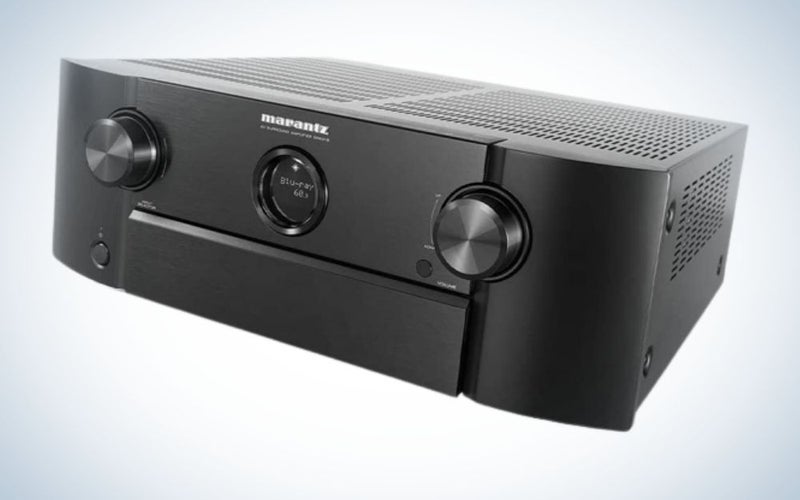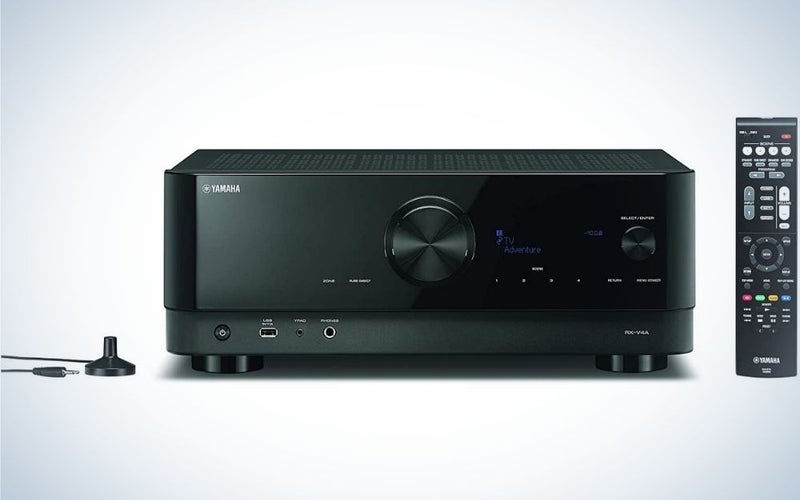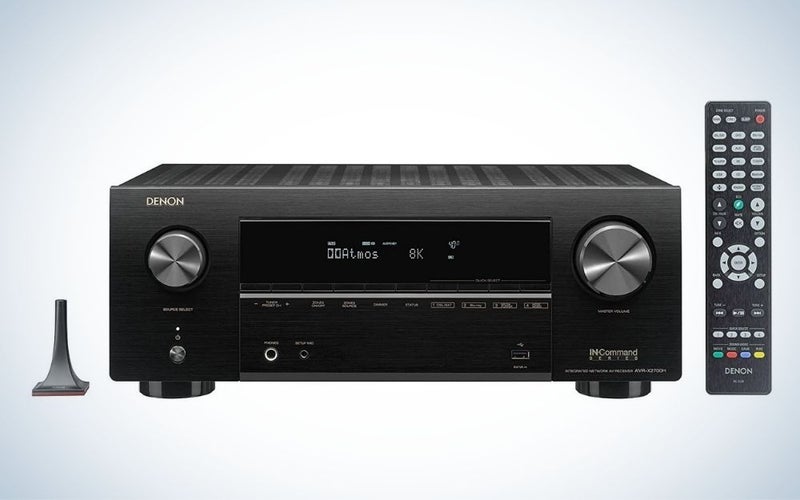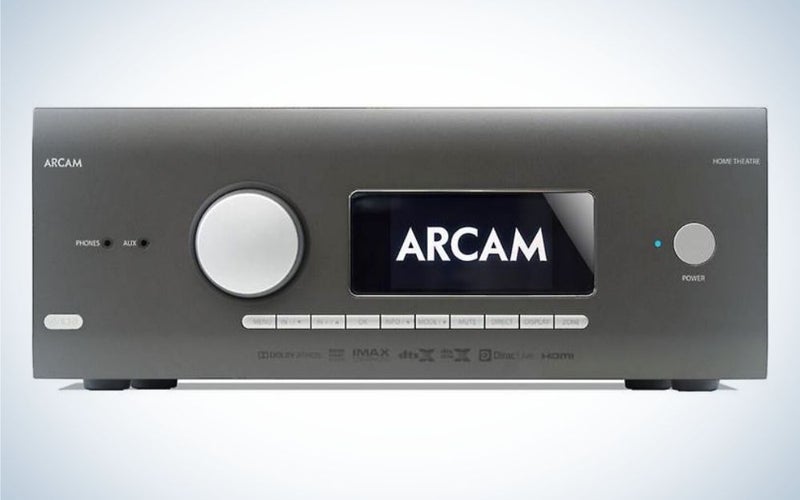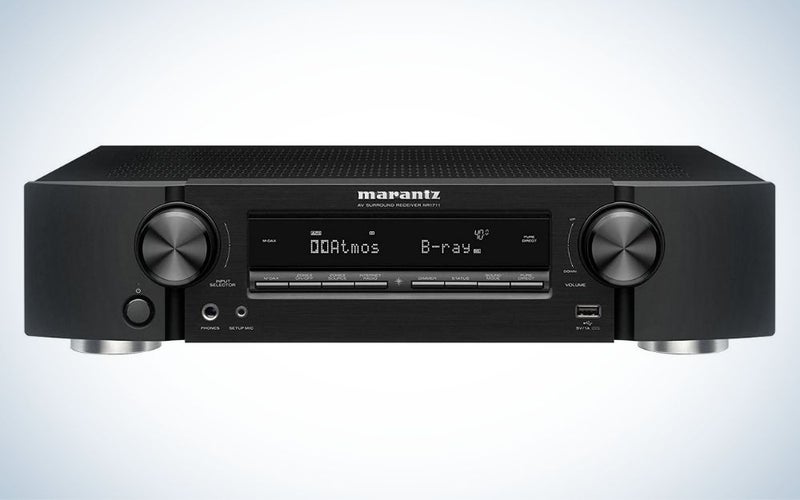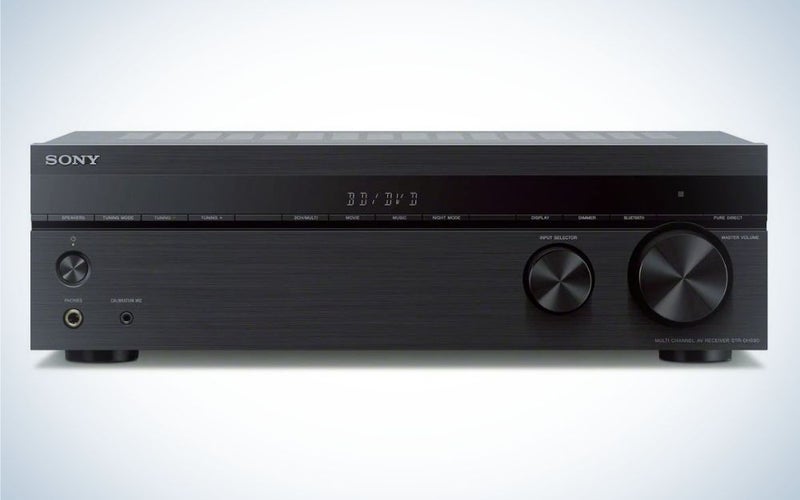We may earn revenue from the products available on this page and participate in affiliate programs. Learn more ›
If you’re setting up a home theater, a killer game rig, or even a multiroom music system, an AV receiver (AVR) is necessary for tying it all together. It can function as your system’s hub, accepting, decoding, and routing various audio sources and formats, passing through HDMI signals, and providing connection and amplification for all your speakers. In the alphabet-soup world of home-entertainment technology, figuring out which AVR is right for you isn’t easy. We aim to inform and demystify your shopping experience by recommending the best AV receivers in various price ranges and for different applications.
- Best overall: Marantz SR6015
- Best 4K under $500: Yamaha RX-4VA
- Best 7.2: Denon AVR-X2700H
- Best for home theater: Arcam AVR31
- Best gaming: Marantz NR1711
- Best budget: Sony STRDH590
How we chose the best AV receivers
We considered dozens of the best AV receivers and amplifiers for this story and focus on those that offer overall excellence in their price range. We also wanted to present products that excel for specific applications, such as gaming or audiophile music listening or multichannel surround sound. All our recommended units are made by solid, reputable companies and should give you years of excellent performance. The PopSci writers and editors have decades of combined experience writing about technology and home theater gear. These recommendations are a mixture of first-hand experience, spec comparisons, user impressions, peer recommendations, and scouring critical AV receiver reviews.
The best AV receivers: Reviews & Recommendations
The best AV receivers integrate the various components in your home theater and music system. Most offer optical and analog (RCA) inputs in addition to their HDMI ports. That way, AVRs can incorporate digital sources like Blu-ray players, streaming devices, game consoles, smart TVs, analog turntables (although you might need a phono preamp), or older CD or DVD players. AVRs receive audio over the internet (some by Wi-Fi and others Ethernet) and via Bluetooth from your mobile devices; many can provide wireless multiroom audio. A home theater with a music system and maybe a gaming system would be unmanageable without an AV receiver as its nerve center. You can assume that each AVR we mention includes a remote control and a setup/calibration system.
Best overall: Marantz SR6015
Marantz
Why it made the cut: Get it for the Marantz sound quality and enough channels for true Dolby Atmos.
Specs
- Channels: 9.2
- Power: 110W per channel (into 8 Ohms, THD: 0.08%, 2-ch driven)
- HDMI ports: 7in/3 out
- Highest Video Supported: 8K
Pros
- High-quality Marantz audio
- Dolby Atmos and DTS:X, both hardwired and virtual.
- Built-in HEOS
Cons
- Remote lacks backlight
Marantz has a longstanding reputation for high-quality sound, so it’s no surprise that the 9.2-channel SR6015 offers audiophile quality. It includes a phono input to connect your turntable without an external preamp and sports separate 110W amplifiers for each channel. As for HDMI ports, you get a generous seven inputs and three outputs. One of the inputs is dedicated to 8K video pass-through at 60Hz and 4K at 120Hz. It’s more than capable if you want to set up a 5.1.4 or 7.1.2 Dolby Atmos system. It also supports Dolby Atmos Height Virtualization and DTS:X, DTS Virtual:X, and other multichannel sound formats. It also features built-in HEOS (Home Entertainment Operating System) if you want to create a multi-room system. Its remote lacks a backlight; otherwise, this is a killer AVR that delivers everything a true music and movie lover would need and more for around $2,000.
Best 4K under $500: Yamaha RX-4VA
YAMAHA
Why it made the cut: It offers a surprisingly rich feature set for the money if you don’t need every bell and whistle.
Specs
- Channels: 5.2
- Power: 80W per channel (into 6 ohms, 0.06% THD)
- HDMI ports: 4 in/1 out
- Highest video supported: 4K currently, 8K upgrade via firmware available soon
Pros
- Affordable price for a surround-capable receiver
- Supports multiple video and music formats
- Will support 8K and VRR, QMS, ALLM and QFT with a future firmware update
Cons
- Requires (free) HDMI board replacement for 4K/120Hz gaming
- No Dolby Atmos height virtualization or DTS Virtual:X support
- No phono input
This 5.2-channel unit makes a solid centerpiece for home theater, gaming, and music listening. With four HDMI 2.1 inputs and an eARC output—along with optical, coaxial, and analog RCA inputs (but no phono inputs for a turntable)—it’s compatible with a wide range of gear. The unit supports Dolby and DTS surround sound decoding, streaming via Wi-Fi, Apple AirPlay 2, and Spotify Connect, and can be voice-controlled with Amazon Alexa or Google Assistant.
The RX-4VA comes with Yamaha’s MusicCast multiroom system (minus the speakers, of course), allowing you to connect with other compatible Yamaha components wirelessly. A USB port lets you play music from an external storage device.
On the negative side, the RX-4VA doesn’t support virtualized Dolby Atmos or DTS Virtual:X. It’s also one of the receivers whose chipset has an HDMI 2.1 bug that cannot handle 4K/120Hz gaming for Xbox Series X or NVIDIA RTX30. Fortunately, Yamaha offers a free HDMI board update program to fix it. Although it supports HDMI 2.1, it doesn’t support 8K out of the box. However, Yamaha will soon offer a firmware update that will add 8K capabilities as well as VRR (Variable Refresh Rate), ALLM (Auto Low-Latency Mode), QMS (Quick Media Switching), and QFT (Quick Frame Transport), which are HDMI 2.1 features designed to enhance gaming. Together, this makes it a top-value 4K AV receiver that retails for $599 but is typically offered under $500 and is future-proofed for when 8K flatscreens come down to a more approachable price.
Best 7.2: Denon AVR-X2700H
Denon
Why it made the cut: This mid-priced AVR has a full feature set and is ready for the future.
Specs
- Channels: 7.2
- Power: 95W per channel (into 8 ohms, THD: 0.08%)
- HDMI ports: 6 in /2 out
- Highest video supported: 8K
Pros
- Great sound quality
- Broad multichannel format support
- Lots of connectivity options
Cons
- None to speak of
By shelling out around $800 for this unit, you get an AVR with an impressive feature set that should remain relevant for at least five years for both home theater and gaming. Serving up a solid 95W of power per channel, the AVR-X2700H (which replaces the AVR-X2600H) passes through 8K/60Hz and 4K/120Hz video and supports Dolby Atmos, Atmos Height Virtualization, DTS:X, DTS Virtual:X surround audio formats.
It’s a Bluetooth AV receiver, as well as one with Wi-Fi, so you have many connectivity options, including Apple AirPlay, Spotify Connect, USB, HEOS, and even terrestrial radio. It’s compatible with all the major voice control formats, including Alexa, Siri, and Google Assistant. If you’re into vinyl, the unit has phono inputs for MM-cartridge turntables.
Best for home theater: Arcam AVR31
Arcam
Why it made the cut: It can process up to 16 channels of multichannel audio.
Specs
- Channels: 7.2
- Power: 120W per channel (into 8 ohms at 0.02% THD, 2-ch driven)
- HDMI ports: 7in/3 out (HDMI 2.1)
- Highest Video Supported: 8K
Pros
- 16 channels of processing
- Broad multichannel format support
- Dirac Live room correction tailors the sound to your room’s acoustics (microphone included)
- Class G amplification provides excellent sound
- Spotify Connect, TIDAL Connect, MQA, and Roon support
Cons
- No phono input for turntable two-channel use
- Price
Arcam’s high-end AV receiver offers seven Class G amplification channels, which offer better efficiency than the more typical class B or AB designs. It also can process 16 channels simultaneously. Using its preamp-outs to feed an additional power amp, you could configure a 15.2 system. The AVR31 has Dirac Live room correction and a measurement mic to calibrate all those speakers correctly.
Moreover, it offers broad support of multichannel audio formats: Dolby Atmos, TrueHD, Digital Plus, DTS:X (but not DTS:X Pro), IMAX Enhanced, and Auro 3D. From an HDMI standpoint, it offers seven in and three out, including one eARC output. All HDMI is 2.1, supporting 4K/120Hz and 8K/60Hz signals (but no VRR/ALLM). HDCP 2.3 technology and Dolby Vision, HDR10, HDR10+, and HLG support even ensure compatibility with 4K and 8K Ultra HD sources and TVs. But there isn’t really 8K content to concern yourself with, so if your goal is a pure signal path and clean power that can convey any soundtrack’s every nuance, you’ll get what you pay for (and you’ll pay around $5,500 on average).
Unlike Arcam’s previous generation, the AVR31 has Bluetooth Audio w/ aptX HD, Wi-Fi, Apple AirPlay 2, Google Chromecast support, and an FM tuner. You’ll need a phono preamp to connect a turntable. But overall, if you’re looking to set up a massive multichannel system in your home theater, the AVR30 makes an outstanding central hub to build around.
Best gaming: Marantz NR1711
Marantz
Why it made the cut: The half-size frame and full feature set will appeal to gamers and those with space-limited home theater setups.
Specs
- Channels: 7.2
- Power: 50W per channel (into 8 ohms, with 0.08 % THD, 2-ch driven)
- HDMI ports: 6in/1out (eARC)
- Highest Video Supported: 8K
Pros
- Slimline form factor saves space
- 8K support provides future-proofing
- Comprehensive implementation of Dolby and DTS multichannel formats
Cons
- Only 50W per channel
The NR1711 is a diminutive 3.5 inches in height, about half that of the typical AVR. Yet somehow, Marantz was able to engineer it with a competitive feature set for its $1,000 price range. Because of its half-sized housing, Marantz had to scale down the amplifier size, so its power output is only 50W per channel. But unless you’re setting it up in a large room, it should still give you plenty of oomph.
Gamers short on space will appreciate the NR1711’s “Slimline” form factor. They’ll also love its 8K support, which will serve them well for the next generation of gaming consoles like the PS5 and Xbox Series X. Home theater buffs will appreciate the impressive list of surround formats supported by the NR1711, such as Dolby Atmos, Dolby Speaker Virtualizer, Dolby Digital Plus, and Dolby Surround. DTS is also well represented with DTS:X, DTS Virtual:X, DTS Neural:X, and DTS Digital Surround, to name just some.
You can set up and calibrate your system with built-in Audyssey MultiEQ, Dynamic EQ, and Dynamic Volume processors. If you want to spin some vinyl, the NR1711 sports phono inputs alongside its other analog I/O. Additional goodies include Bluetooth, Wi-Fi support, AirPlay 2, HEOS, and Alexa support.
Best budget: Sony STRDH590
Sony
Why it made the cut: It offers a low-cost path into the surround-sound world.
Specs
- Channels: 5.2
- Power: 90W per channel RMS at 6 ohms, 0.09 percent THD, two channels driven.
- HDMI ports: 4in/1out (ARC)
- Highest video Supported: 4K HDR pass-through
Pros
- Low price for an AVR
- A good option for 5.1 surround
- Quality sonics
Cons
- No Atmos or DTS support
- No HDMI 2.1
- Limited wireless capabilities
The STRDH590 is an entry-level AVR that can handle Ultra-HD content such as 4K Blu-ray and HDR video. With 90W RMS per channel, it has plenty of sonic punch for a small AV receiver, supporting Dolby and DTS surround sound decoding. If you’re looking for Dolby Atmos or DTS:X support, you won’t find it here. But if you’re satisfied with the surround sound from a good old 5.1 AV receiver and don’t care about transitioning to 8K, the STRDH590 is the best 4K AV receiver for you at the $300 price point.
Sony equipped the unit with four HDMI inputs and one ARC out. Notice that it’s not eARC because the STRDH950’s HDMI ports are of the 2.0 variety rather than 2.1. Other input ports include optical, coaxial, and analog. There are no phono inputs, though, so you’d need an external preamp for connecting a turntable. However, you get an FM antenna port and a front-panel USB input for playing music from external drives. The unit includes Digital Cinema Auto Calibration (DCAC) and a built-in measurement mic for setup. For streaming, it features Bluetooth connectivity, so you can pair your mobile device and play music or other audio.
Overall, if you’re not trying to keep up with the latest and greatest but want to watch movies or play games in 5.1 surround sound, the STRDH590 will get you there for less without sacrificing quality. And if you decide you want more connectivity and current at the heart of your system, and have the expanded budget to match, a January 2023 press event unveiled the company’s first new receivers in five years—a lineup including some top-tier contenders.
What to consider when shopping for the best AV receivers
You have many variables to consider with a product as complex as an AVR. Some essential questions include: Can it support what I have (or want to have) in my system? How many HDMI inputs do I need to cover all my gear and have at least one leftover for expansion? Does it support the main surround format I plan to use? Does it deliver enough power per channel to give me plenty of distortion-free volume, given the size of my room? Does it offer 8K support so that I’m future-proofed? Does it have phono inputs for my turntable? Do I need to match my speakers to an AVR? The best AV receivers cover a pretty extensive range of features and prices. Look for the one that will best meet the needs of your current or planned home theater setup.
Is 8K video capability important in an AV receiver?
Right now, 8K isn’t necessary because there’s precious little 8K content available, even if you have an 8K TV. But that will likely change in the next couple of years, and if it’s important for you to watch shows and movies or play games with the best quality available, you’ll need a receiver that supports it. Fortunately, most of the products that we recommend in this article do. The Yamaha RX-4VA doesn’t now but will be able to soon with a simple firmware update.
How many channels do I need if I want a receiver that supports Dolby Atmos?
Atmos is a pretty “hot” format now, offering the dimension of height and the traditional directionality of surround sound to create an even more immersive sonic environment. Many movies now offer Atmos mixes, which can be spectacular. Atmos systems require a receiver with seven channels at the minimum for a hardwired system, consisting of a 5.1 speaker setup with two additional Atmos ceiling-mounted speakers. If you don’t want to mount speakers in the ceiling, you could get Atmos-enabled speakers that fire forward and upward. The latter bounces the sound off your ceiling to simulate having speakers up there. (And don’t forget the speaker wire!)
Another option is an Atmos-enabled soundbar, like the Sennheiser AMBEO or the Sony HT-A7000. Such products create an Atmos-like effect from one multi-speaker device. Finally, several receivers in this roundup support Virtualized Atmos, which simulates Atmos from whatever speaker configuration you have. The soundbar and the virtualized Atmos won’t compare to hardware-based Atmos systems, but you do get some of the effects, and it’s a lot less money. DTS:X is a competitor to Atmos and gives you a similar immersive effect. It also has a simulated version, DTS Virtual:X. Again, it would be best to have a receiver or soundbar that supports it.
HDMI input and output
On the HDMI outputs on AVRs, you’ll see the letters ARC or eARC. ARC stands for Audio Return Channel and eARC (Enhanced Audio Return Channel), introduced with HDMI 2.1. Both ARC and eARC allow bidirectional audio. With the emergence of smart TVs, which stream content from the internet, you need a way to get the audio from that content out of your TV and into your AVR or soundbar so that it gets amplified and routed to speakers. If you have eARC, it supports up to 24-bit/192kHz audio, as well as uncompressed audio from 5.1 and 7.1 surround content. In addition, it works with compressed formats like Dolby Atmos and DTS-HD Master Audio coming from your TV. And don’t forget the HDMI cables!
FAQs
Q: How long do audio receivers last?
The general consensus is that five years is the typical lifespan for an AVR. It’s not like it will just up and die after a certain number of years, like a water heater. Your receiver could function well for 20 years or more. But with the relentless forward march of technology, it will begin to feel like a dinosaur around the five-year mark. Even if you don’t care about staying up with the latest and greatest, there comes a time when it’s hard to resist the allure of new technology.
Q: Do receivers make a difference in sound quality?
Context matters here. A dedicated power amp is superior if you’re talking about music quality. However, AV receivers are much more than just amplifiers. They’re the hub of a home theater or gaming setup (or one that does both) and offer a vast range of wired and wireless connections. Incoming audio gets routed to their amplifiers and into whatever speaker system you use. AVRs can also pass the video content from streaming boxes, cable boxes, Blu-ray players, and game consoles to your television. They don’t process the video; they pass it through in whatever format it’s in, assuming it’s one they support.
Q: Are AV receivers worth it?
The best AV receivers are totally worth it if you want more than just a home stereo system. Don’t get me wrong, we love the compact, self-contained nature of powered speakers. But if you’re looking to create a proper home theater for movies and/or your gaming rig, or want a music system that allows for way more sources than just streaming services, the easiest way to accommodate the diverse range of connectivity required is with an AV receiver. It takes the incoming content—whether from a streaming box, a set-top box, a gaming console, a turntable, or other physical media—processes it in the appropriate format (assuming it supports it) and sends the audio off to the speakers while sending the video through to your TV. What’s more, most AVRs offer some form of multi-room audio, so if you get the appropriate speakers, you can also run audio to your entire house or apartment from your receiver.
Q: How many watts per channel do I need?
While the appropriate answer is ultimately based on the recommended amplification range of your speakers, 50W-100W per channel is typically more than enough to satisfy the vast majority of surround sound speakers (75W being the sweet spot in a 5.1 or 7.1 system). That’s not to say there aren’t speakers that require a higher RMS rating, but if that’s the kind you’re looking at, you probably know you’ll need to look at higher-end AV receivers or even discrete amplification (maybe you’re even working with an integrator).
Final thoughts on the best AV receivers
- Best overall: Marantz SR6015
- Best 4K under $500: Yamaha RX-4VA
- Best 7.2: Denon AVR-X2700H
- Best for home theater: Arcam AVR31
- Best gaming: Marantz NR1711
- Best budget: Sony STRDH590
As you may have noticed from our roundup, there are a lot of choices and a wide range of prices in the AVR market. To decide which is right for you, you need to consider the price and the kind of system you’re trying to create. Do you want to move from 5.1 to a more complex multichannel format, like a 7.1 or an Atmos system? Will you also have to upgrade your TV and speaker system to achieve your goals? Because AV receivers are multifaceted and encompass or support so many technologies, it helps to be as informed as possible when deciding which one to buy. In this article, we’ve offered you a diverse range of products and information. However, you still have plenty of issues to consider regarding the specifics of your system, the space you’re putting it in, and your goals for the system before you can choose which of the best AV receivers is best for your needs.
Why trust us
Popular Science started writing about technology more than 150 years ago. There was no such thing as “gadget writing” when we published our first issue in 1872, but if there was, our mission to demystify the world of innovation for everyday readers means we would have been all over it. Here in the present, PopSci is fully committed to helping readers navigate the increasingly intimidating array of devices on the market right now.
Our writers and editors have combined decades of experience covering and reviewing consumer electronics. We each have our own obsessive specialties—from high-end audio to video games to cameras and beyond—but when we’re reviewing devices outside of our immediate wheelhouses, we do our best to seek out trustworthy voices and opinions to help guide people to the very best recommendations. We know we don’t know everything, but we’re excited to live through the analysis paralysis that internet shopping can spur so readers don’t have to.

